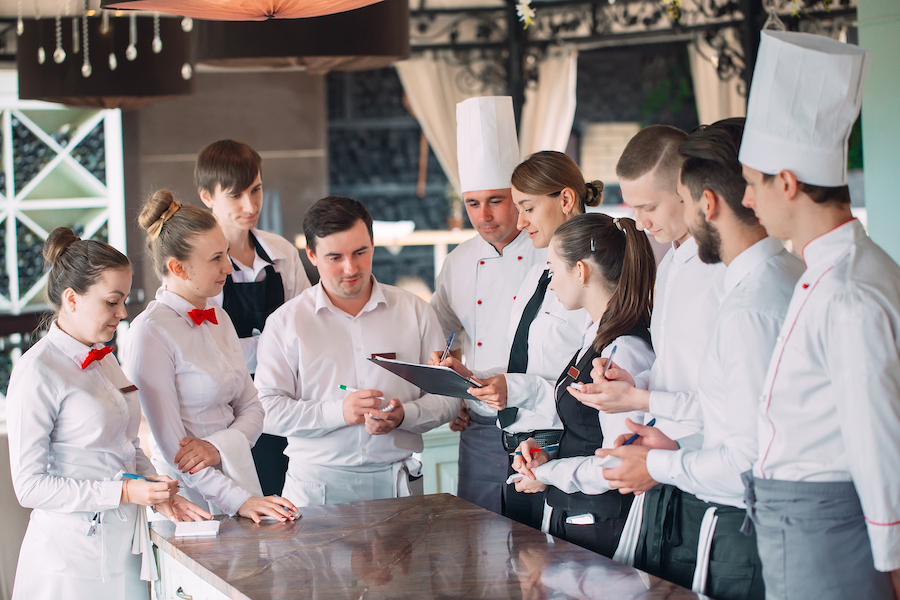- 1.What Is Restaurant Communication?
- 2.Best Practices to Perfect Your Restaurant Communication
- Aim for consistency
- Digitize communications
- Keep track of what’s been said
- Use the correct communication channel for the situation
- Make comms tools as accessible as possible
- Consider using AI to support your comms
- Really listen
- Integrate great communication into your restaurant culture
- 3.The Takeaway
Running an amazing eatery relies, at least in part, on having top-tier restaurant communication—but how can you ensure this?
In this article, we’ll cover some useful tips to follow if you want to boost your communication and make a splash in the restaurant industry. These will help you get it right every time and ensure you’re streamlining communication processes wherever possible.
Before that, though, let’s look at what restaurant communication is.
What Is Restaurant Communication?
There are two kinds of restaurant communication: internal and external. We’ll explore both of them below.
Firstly, internal communication is the one that takes place between team members or teams. Anytime one of your waitstaff relays a customer’s order to the kitchen, that’s internal communication in action. Likewise, managers allocating shifts, handling employee complaints, delegating tasks, or discussing ideas are all examples of internal comms.
External communication, on the other hand, takes place between your restaurant and its customers. For example, whenever you put out promotional material, you’re engaging in external communication.
Best Practices to Perfect Your Restaurant Communication
The following tips will help you get your restaurant communication right.
1. Aim for consistency
From your restaurant branding to the kinds of words you use (and avoid), consistency is vital.
When it comes to external comms, any messages you send out must be consistent with your brand identity. If you’re a more casual, down-to-earth type of restaurant, for example, don’t contact your customers using an obscure vocabulary or long, winding sentences.
In terms of internal comms, consistency is often about finding the clearest way to communicate ideas and then sticking with this.
For instance, if your managers are looking to allocate shifts, they should use unambiguous phrases their teammates are familiar with. This is a time to be predictable rather than creative.
2. Digitize communications
Restaurants have been around for centuries—but that doesn’t mean communication styles have to be outdated.
We live in a digital era, and eateries can capitalize on this fact by digitizing their comms e.g. by switching over to modern, internet-based tools in place of pen and paper. This makes it easier to track conversations and see what’s been said to who.
Your restaurant might also want to use a VoIP number to allow customers and team members to place calls using the internet instead of a cellular connection. This saves money while ensuring you’re always contactable so long as you have a Wi-Fi connection.
3. Keep track of what’s been said
It’s a good idea to keep written records of communications wherever possible, whether conversations are over the phone, the internet, or face-to-face. This sort of record lets you read back over what was said, so you can verify and fact-check conversations quickly and easily.
In the case of external comms, this means having concrete proof of information like customers’ orders or allergy details. If a customer tries to claim they didn’t order what they received, you’ll be able to prove them right or wrong and react accordingly.
Internal comms also benefit from keeping written logs. Anytime you’re looking for information on who said what or whether the news was properly communicated, you can check back and verify this.
4. Use the correct communication channel for the situation
Not every conversation, message, or topic will be suited to a singular means of communication.
For example, sending a brief reminder via business SMS can be ideal, whereas communicating the same information over the phone takes a lot of time and might disturb people’s concentration at work.
In short, what you need to do is use the right communication channel for any given situation.
You can do this most effectively by making plenty of communication channels available for business comms. For example, employees should have access to voice and video calls, SMS, emails, group chats, and other text-based channels for sharing information.
Where possible, try to find a solution that lets you access these various channels from a single app. A UCaaS (unified communications as a service) tool might be ideal, allowing you to keep all your communications in one place.
5. Make comms tools as accessible as possible
One of the goals of restaurant communication is to ensure staff members and customers can talk to and message each other effectively. That’s much easier to achieve with accessible tools.
Restaurants often go through chaotic/hectic periods (hello, lunch and dinner rush). This makes it doubly important to choose tools that can keep up with this demand.
Comms tools should also be usable on mobile devices to facilitate interactions on the go.
6. Consider using AI to support your comms
Great communication isn’t always an easy goal to achieve, particularly if you’re not using the right tools. That’s why you can use an AI solution to facilitate and support effective comms.
With the help of AI-powered tools like Front Telegram, for example, you can turn over admin tasks like group management and contact creation to a bot.
This takes a lot of the effort out of communicating for human employees, who can focus on the conversations they’re having rather than taking down contact details and so on.
7. Really listen
There’s a major difference between listening so you can get a chance to speak and listening to absorb others’ thoughts, ideas, and opinions. You should be aiming for the latter.
When you take the time to properly listen to the people you’re speaking with, you give them a chance to express themselves. This reduces the likelihood of miscommunication.
It also helps you form stronger bonds, because you’re better able to understand them and their viewpoints. This applies to both internal and external comms.
In return, you can encourage other members of staff to do the same for you. This stops you from having to repeat yourself and allows others to ask meaningful questions that enhance their understanding.
8. Integrate great communication into your restaurant culture
To build and cultivate a strong restaurant culture, ensure that yours is the kind of workplace where employees know they’re expected to hone their communication skills.
On top of helping lower the risk of information and intentions getting lost in conversation, this encourages stronger bonds among your team and more efficient partnerships.
You can begin incorporating communication into your restaurant culture by actively seeking out this skill in new hires. You can also provide training to existing employees to help them improve. It’s helpful to praise instances of excellent communication whenever you see them too.
The Takeaway
Restaurant communication sits at the heart of teamwork—you can’t work well as a collective without first knowing how to speak to one another. That’s why effective restaurant comms are the key to success, and why they keep things running smoothly on a daily basis.
In short, boosting your internal and external communication is well worth the effort it entails. It’s great for team morale and helps you retain employees while also attracting more customers.
This article is a guest post.


